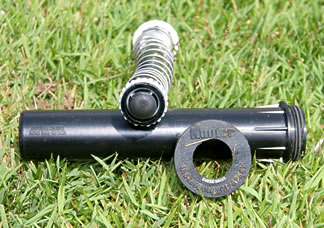Check valves
- Home
- /
- Technical Manual
- /
- Irrigation system criteria
- /
- General design
- /
- Check valves
Background
Water pressure in an irrigation system will affect the performance of sprinklers and emitters. The accumulated weight of water increases pressure as gravity pulls on water. Sprinkler height differential creates varying pressures. Thus pressures can build at lower heads.

This additional pressure can cause a standard irrigation head to remain partially open and “weep” or “bleed” after the solenoid valve closes, which causes any remaining water in the pipe to drain out and go to waste. Up to 1 gallon of water can leak from low-lying heads every time the system shuts off. Significant water loss can occur over time in systems with numerous low-lying heads.

A check valve is a component that increases the resistance of the sprinkler pop-up mechanism and prevents water from weeping out.
Requirements and certification
Sprinklers in low-lying areas shall have check valves.
| Silver | Gold | Commercial/Institutional |
|---|---|---|
| Required | Required | Required |
Locations that typically require check valves are the site perimeters that are at a low point in a slope away from the building. Heads requiring check valves must be clearly identified on the irrigation system design and are to be field-verified by Florida Water Star Inspectors.
